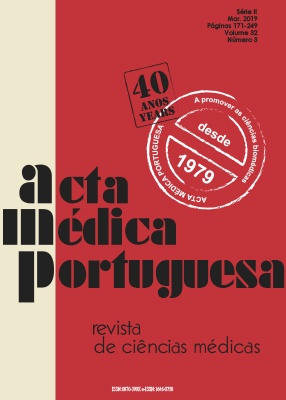Lipoprotein(a) in the Evaluation of Cardiovascular Risk in the Portuguese Population
DOI:
https://doi.org/10.20344/amp.10251Keywords:
Atherosclerosis, Cardiovascular Diseases, Lipoprotein(a), Portugal, Primary PreventionAbstract
Introduction: High values of lipoprotein(a), related to atherosclerosis progression, are often considered a marker of thrombosis. We assessed the lipoprotein(a) profile in a group of patients with high vascular risk and no cardiovascular events, established its correlation with other cardiovascular risk factors and inferred the results for patients with metabolic disorders and, at least, two risk factors.
Material and Methods: This longitudinal observational study included 516 patients, who had at least two cardiovascular risk factors and regularly attended, for at least two years, the outpatient consultations at a clinic of metabolism and vascular risk for primary prevention. Sociodemographic, clinical and anthropometric parameters were obtained at the baseline visit. Hepatic morphology was assessed in 509 patients (98.6%) by ultrasonography. The 10-year vascular risk was estimated using Framingham risk score, atherosclerotic cardiovascular disease and systematic coronary risk evaluation tables.
Results: Significant correlations were found between lipoprotein(a) levels and the addressed vascular risk factors, as well as between lipoprotein(a), and Framingham risk score, atherosclerotic cardiovascular disease and systematic coronary risk evaluation charts. Lipoprotein(a) values were also considerably higher in patients with steatosis.
Discussion: Increased lipoprotein(a) values were directly associated with all markers of cardiovascular risk and with non-alcoholic hepatic steatosis.
Conclusion: Due to its high availability and low cost, lipoprotein(a) should become part of the routine evaluation of patients at vascular risk.
Downloads
Downloads
Published
How to Cite
Issue
Section
License
All the articles published in the AMP are open access and comply with the requirements of funding agencies or academic institutions. The AMP is governed by the terms of the Creative Commons ‘Attribution – Non-Commercial Use - (CC-BY-NC)’ license, regarding the use by third parties.
It is the author’s responsibility to obtain approval for the reproduction of figures, tables, etc. from other publications.
Upon acceptance of an article for publication, the authors will be asked to complete the ICMJE “Copyright Liability and Copyright Sharing Statement “(http://www.actamedicaportuguesa.com/info/AMP-NormasPublicacao.pdf) and the “Declaration of Potential Conflicts of Interest” (http:// www.icmje.org/conflicts-of-interest). An e-mail will be sent to the corresponding author to acknowledge receipt of the manuscript.
After publication, the authors are authorised to make their articles available in repositories of their institutions of origin, as long as they always mention where they were published and according to the Creative Commons license.









